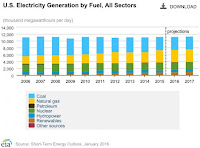In a stunning trend with broad implications, the U.S. economy has grown significantly since 2007, while electricity consumption has been flat, and total energy demand actually dropped.
“The U.S. economy has now grown by 10% since 2007, while primary energy consumption has fallen by 2.4%,” reports Bloomberg New Energy Finance (BNEF) in its newly-released 2016 Sustainable Energy in America Factbook. BNEF’s Factbook, which is chock full of excellent charts and data, cites studies attributing most of this change to improvements in energy efficiency.
Equally remarkable, this “decoupling” between energy consumption and GDP growth extends to the power sector: “Since 2007, electricity demand has been flat, compared to a compounded annual growth rate of 2.4% from 1990 to 2000.” As I discussed in my recent renewables series, this decoupling is an unprecedented achievement in modern U.S. history. It may seem especially remarkable for an economy underpinned by soaring usage of the internet and electronic equipment — but as I wrote in a 1999 report, a true Internet-based economy was always likely to be a more efficient economy.
The decoupling of GDP growth from energy and electricity consumption has been a key reason the United States has been able to reduce its overall greenhouse gas emissions since 2005. In particular, flat electricity demand has meant that the explosive growth in renewables and natural gas power has come directly at the expense of dirty coal, as this 2016 Energy Information Administration chart shows:
The key driver of the decoupling of electricity use and GDP growth is energy efficiency policy and investment. BNEF notes that in 2014 (the most recent year we have data for), “Natural gas and electric utility spending on efficiency reached $6.7bn, up 8.1% from the $6.2bn seen in 2013; Energy Savings Performance Contracting (ESPC) investment topped $6.4bn.” The ESPC funding is generally distinct from the utility funding and “mainly focused on public buildings.”
Since 2006, utility efficiency spending is up four-fold. The result is that “since 2007, incremental efficiency achievements have risen 17% on average annually.”
Read more at U.S. Economic Growth Decouples from Both Energy and Electricity Use


No comments:
Post a Comment